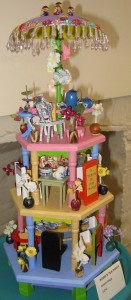 This is dedicated to Judy Chicago, without whom a whole generation or two of women would not have become artists. For one thing, along with others such as Georgia O’Keeffe, she legitimised the use of the flower as a female motif. She called the autobiography of her development as a woman artist in a male world in the sixties and seventies “Through the Flower”. More importantly, through her collaborative touring piece “The Dinner Party”, she brought to the general public many forgotten and neglected important women artists, writers and philanthropists. I saw “The Dinner Party” in Edinburgh in 1984, and was overwhelmed by its ambition, beauty and craftsmanship. It took eight years and over 400 volunteers to complete.
This is dedicated to Judy Chicago, without whom a whole generation or two of women would not have become artists. For one thing, along with others such as Georgia O’Keeffe, she legitimised the use of the flower as a female motif. She called the autobiography of her development as a woman artist in a male world in the sixties and seventies “Through the Flower”. More importantly, through her collaborative touring piece “The Dinner Party”, she brought to the general public many forgotten and neglected important women artists, writers and philanthropists. I saw “The Dinner Party” in Edinburgh in 1984, and was overwhelmed by its ambition, beauty and craftsmanship. It took eight years and over 400 volunteers to complete.
“Rosie’s Tea Party” is my miniature salutation to a great woman who changed the face of art history. It contains fourteen empty chairs, made ready for some of the women who have inspired me. Each chair expresses something about the woman, has a card with her name on it and a brief quotation encapsulating what she has meant to me. The tea party is deliberately crowded to show how many there are, and how many there aren’t room for.
The women invited to Rosie’s Tea Party
| Dorothy Wordsworth 1771–1855 | “I never saw daffodils so beautiful” |
| Jane Austen 1775 – 1817 | “a little piece of ivory, two inches wide” |
| Madge Gill 1882 – 1961 | “I wish I could be normal” |
| Dorothy Parker 1893 – 1967 | “sorrow clings to my apron strings” |
| Virginia Woolf 1882 – 1941 | “every day includes much more non-being than being” |
| Dora Carrington 1893 – 1932 | “I would like to draw all day” |
| Georgia O’Keeffe 1887 – 1986 | “making your unknown known” |
| Alice Miller 1923 – 2010 | “I betrayed that little girl” |
| Hildegard von Bingen 1098–1179 | “co-creators with God in everything we do” |
| Emily Dickinson 1830 – 1886 | “They shut me up in Prose” |
| Clarissa Pinkola Estes 1945 - | “Be wild” |
| Bridget Riley 1931 – | “being an artist is lonely” |
| Sharon Olds 1942 - | “woman like a gaping wound” |
| Anne Redpath 1895 – 1965 | “’sugary’ with a ‘feminine’ sense of colour” (How her work was described by a critic) |